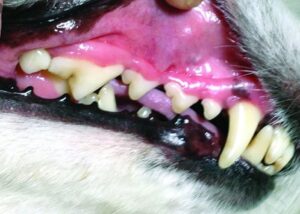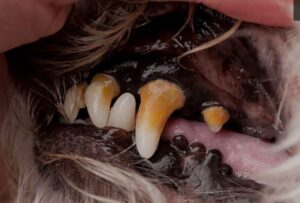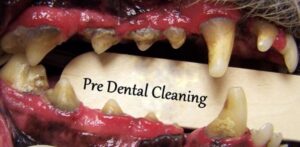Hurricane season started on Tuesday, June 1st, 2021. NOAA’s Climate Prediction Center is forecasting another above-normal Atlantic hurricane season. For 2021, a likely range of 13 to 20 named storms, of which 6 to 10 could become hurricanes, including 3 to 5 major hurricanes (category 3, 4 or 5) is expected.
According to the National Weather Service,  hurricane preparedness starts now, when you have the time and are not under pressure from an approaching storm. This is also applicable for your animals (small and large). Your pets are an important member of your family, so they need to be included in your family’s emergency plan.
hurricane preparedness starts now, when you have the time and are not under pressure from an approaching storm. This is also applicable for your animals (small and large). Your pets are an important member of your family, so they need to be included in your family’s emergency plan.
For all your animals, there are three basic points to consider:
- Prepare a disaster plan.
- Build an emergency kit.
- Stay informed.
Here, we will cover only these points to prepare your companion animals/pets for an emergency. However, keep in mind that many of these steps are also applicable in any emergency.
- Develop an evacuation plan for all your animals and practice the plan. If local officials asked you to evacuate, that means your pet should evacuate too.
-
- Identify alternate sources of food and water b. Keep vehicles well maintained and full of gas.
- Keep emergency cash on hand.
- Keep identification on your pets including rabies and license tags. Identification should provide your name, home address, and/or phone number(s) i.e., collar tags, microchips, tattoo.
- Make photocopies of important veterinary documents and proof of ownership.
- Assemble an animal evacuation kit.
- Prepare your emergency contact list now, before disaster strikes. Include addresses and 24-hour contact numbers, if available.

-
- Just as you do with your family’s emergency supply kit, think first about the basics for survival, such as food and water. Have two kits, one larger kit if you are sheltering in place and one lightweight version for if you need to evacuate. Assemble the kit in easy-to-carry, waterproof containers. Store it in an easily accessible location away from areas with temperature extremes. Replace the food, water, and medications as often as needed. Consider the following to include in your kit:
-
- Two-week supply of food (dry & canned). Spoon (for canned food)
- Two-week supply of water in plastic gallon jugs with secure lids
- Batteries (flashlight, radio)
- Cage/carrier (one for each animal, labeled with your contact information)
- Can opener (manual)
- Copies of veterinary records and proof of ownership
- Emergency contact list
- Familiar items to make pets feel comfortable (favorite toys, treats, blankets)
- Flashlight
- Diet: record the diet for each individual animal, including what not to feed in case of allergies.
- Medications: list each animal separately, and for each medication include the drug name, dose, and frequency. Provide veterinary and pharmacy contact information for refills.
- Leash and collar or harness (for each animal)
- Litter, litter pan, litter scoop
- Maps of local area and alternate evacuation routes
- Muzzles (dog or cat)
- Newspaper (bedding, litter)
- No-spill food and water dishes
- Paper towels
- Radio (solar and battery operated)
- Stakes and tie-outs
- Trash bags
- Pet shampoo
-
- A first-aid kit for your pets is also important to prepare. Talk to your veterinarian about what is most appropriate for your pet’s emergency medical needs. The list below is not comprehensive and serves as an example.
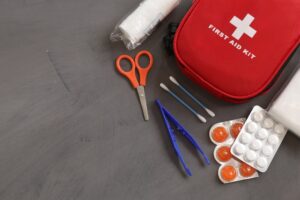
-
-
-
- Anti-diarrheal liquid or tablets
- Antibiotic ointment (for wounds)
- Bandages, bandage tape
- Disinfectant
- Cotton bandage rolls
- Cotton-tipped swabs
- Elastic bandage rolls
- Flea and tick prevention and treatment
- Gauze
- Alcohol
- Saline or mild wound and body cleanser
- Medications and preventatives (such as heartworm prevention)
- Non-adherent bandage pads
- Styptic powder (clotting agent)
- Syringe or eyedropper
- Thermometer
- Towel and washcloth
-
-
- Stay informed and be prepared for changing conditions. Plan with neighbors, friends, or relatives to make sure that someone is available to care for or evacuate your pets if you are unable to do so.
Lastly, keep in mind that the Atlantic hurricane season extends from June 1 through November 30.
For more information:
https://www.noaa.gov/media-release/noaa-predicts-another-active-atlantic-hurricane-season
https://www.ready.gov/hurricanes#
https://ors.od.nih.gov/ser/dem/emergencyPrep/Pages/Caring%20for%20Animals.aspx



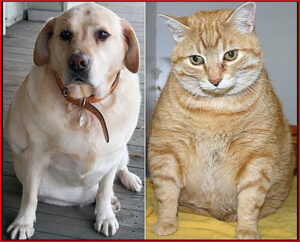 Obesity is not just the accumulation of large amounts of adipose tissue but is associated with important metabolic and hormonal changes in the body. Few diseases in modern veterinary medicine are diet induced with one possible exception, obesity. The cause of obesity is multifactorial with genetics, physical activity, and diet energy content as predisposing factors. There are numerous concerns regarding obesity, the first one is that it seems to be increasing in prevalence. Furthermore, excess body fat has adverse metabolic consequences, including insulin resistance, altered hormonal secretion, changes in metabolic rate, abnormal lipid metabolism, and fat accumulation in visceral organs. Numerous studies demonstrated that obesity could have detrimental effects on the health and longevity of dogs and cats. Like obese pet parents, obese companion animals may be predisposed to other serious conditions including orthopedic disease, diabetes mellitus, abnormalities in blood lipid values, cardiorespiratory disease, urinary disorders, reproductive disorders, reproductive and renal cancers. A lifelong study in dogs showed that even moderately overweight dogs were at greater risk for earlier mortality. Likewise, obese cats face increased health risks including arthritis, diabetes mellitus, fatty liver disease, and early mortality. The risk for development of diabetes increases in overweight cats and is about four-fold in obese cats.
Obesity is not just the accumulation of large amounts of adipose tissue but is associated with important metabolic and hormonal changes in the body. Few diseases in modern veterinary medicine are diet induced with one possible exception, obesity. The cause of obesity is multifactorial with genetics, physical activity, and diet energy content as predisposing factors. There are numerous concerns regarding obesity, the first one is that it seems to be increasing in prevalence. Furthermore, excess body fat has adverse metabolic consequences, including insulin resistance, altered hormonal secretion, changes in metabolic rate, abnormal lipid metabolism, and fat accumulation in visceral organs. Numerous studies demonstrated that obesity could have detrimental effects on the health and longevity of dogs and cats. Like obese pet parents, obese companion animals may be predisposed to other serious conditions including orthopedic disease, diabetes mellitus, abnormalities in blood lipid values, cardiorespiratory disease, urinary disorders, reproductive disorders, reproductive and renal cancers. A lifelong study in dogs showed that even moderately overweight dogs were at greater risk for earlier mortality. Likewise, obese cats face increased health risks including arthritis, diabetes mellitus, fatty liver disease, and early mortality. The risk for development of diabetes increases in overweight cats and is about four-fold in obese cats.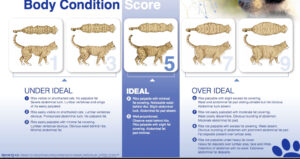
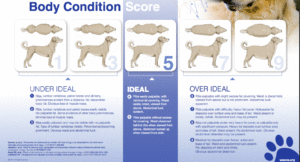 Controlling our pet’s weight is one of the two (we discussed the other in this
Controlling our pet’s weight is one of the two (we discussed the other in this 
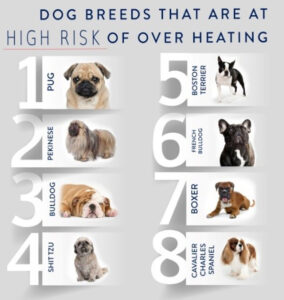 confinement in a poorly ventilated area, strenuous exercise, and/or being left in a vehicle even on a relatively cool day as temperatures inside vehicles can increase rapidly regardless of the outside temperature. Heatstroke can affect all dog breed of any age but, long-haired and brachycephalic breeds (Pugs, Bulldogs and other flat-faced breeds) are more susceptible. Other predisposing characteristics include age (young puppies or geriatric dogs), obesity, pre-existing diseases and physical condition.
confinement in a poorly ventilated area, strenuous exercise, and/or being left in a vehicle even on a relatively cool day as temperatures inside vehicles can increase rapidly regardless of the outside temperature. Heatstroke can affect all dog breed of any age but, long-haired and brachycephalic breeds (Pugs, Bulldogs and other flat-faced breeds) are more susceptible. Other predisposing characteristics include age (young puppies or geriatric dogs), obesity, pre-existing diseases and physical condition.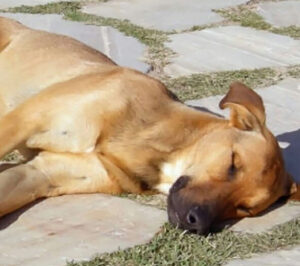 Unlike humans, dogs do not sweat but eliminate heat by panting instead. Dogs have some sweat glands in the footpads, which help with heat dissipation, but only minimally. When panting is not enough, a dog’s body temperature rises. This can be fatal if not corrected quickly. Signs of heat stroke are excessive panting, signs of discomfort, unable or unwilling to move around, red mucous membranes, hypersalivation, rapid heart rate, dry nose, vomiting, diarrhea muscle tremors, seizures, ataxia (impaired coordination), coma and death.
Unlike humans, dogs do not sweat but eliminate heat by panting instead. Dogs have some sweat glands in the footpads, which help with heat dissipation, but only minimally. When panting is not enough, a dog’s body temperature rises. This can be fatal if not corrected quickly. Signs of heat stroke are excessive panting, signs of discomfort, unable or unwilling to move around, red mucous membranes, hypersalivation, rapid heart rate, dry nose, vomiting, diarrhea muscle tremors, seizures, ataxia (impaired coordination), coma and death.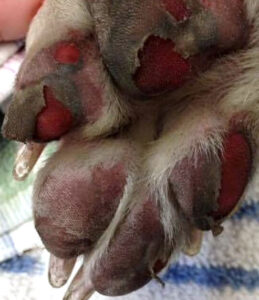 If you suspect heatstroke, stop all activity and walk or carry your dog to a cool, shaded area with good air circulation. It is essential to remove the dog from the hot environment immediately. Let your dog drink as much cool water as he wants without forcing him to drink. If you have access to a rectal thermometer, you should take your dog’s temperature. A dog’s normal body temperature is 98.5 to 102.5 F, and heatstroke is classically defined as a core body temperature above 105.8 F. If the temperature is higher than 105 F, using cool, not cold, water; sponge or hose your dog’s entire body, especially the underside, use of a fan is also helpful. After a few minutes retake the temperature and repeat this procedure until the temperature is reduced to 103 F. If the dog is unconscious, place a towel on his back and continue to soak the towel and your dog in cold water. Do NOT submerge your dog’s head in the water. Keep the head elevated to prevent aspiration pneumonia. If the symptoms do not improve quickly and you are unable to take your dog’s temperature take your dog to your veterinarian immediately. On the way to the veterinarian, travel with the windows open and the air conditioner on. It is important to remember that heatstroke in dogs can cause undetected problems, such as swelling of the brain, kidney failure, intestinal bleeding and abnormal blood clotting.
If you suspect heatstroke, stop all activity and walk or carry your dog to a cool, shaded area with good air circulation. It is essential to remove the dog from the hot environment immediately. Let your dog drink as much cool water as he wants without forcing him to drink. If you have access to a rectal thermometer, you should take your dog’s temperature. A dog’s normal body temperature is 98.5 to 102.5 F, and heatstroke is classically defined as a core body temperature above 105.8 F. If the temperature is higher than 105 F, using cool, not cold, water; sponge or hose your dog’s entire body, especially the underside, use of a fan is also helpful. After a few minutes retake the temperature and repeat this procedure until the temperature is reduced to 103 F. If the dog is unconscious, place a towel on his back and continue to soak the towel and your dog in cold water. Do NOT submerge your dog’s head in the water. Keep the head elevated to prevent aspiration pneumonia. If the symptoms do not improve quickly and you are unable to take your dog’s temperature take your dog to your veterinarian immediately. On the way to the veterinarian, travel with the windows open and the air conditioner on. It is important to remember that heatstroke in dogs can cause undetected problems, such as swelling of the brain, kidney failure, intestinal bleeding and abnormal blood clotting. If they are alert enough and able to drink water, offer small amounts frequently. You can add some tuna water or chicken broth to the water to encourage them to drink. Avoid the following: forcing your cat to drink water or pouring water into their mouth, cooling its body with ice or extremely cold water, submerging him in water. Do NOT cool off your cat too fast or skip the trip to the vet. Temperatures can spike again, and there may be damage to internal organs. Unfortunately, cats can be exceptionally good at hiding health problems. If you notice your cat exhibiting any of the symptoms described in dogs and/or sweaty feet, disorientation, restlessness, lethargy and rectal temperature above 105º F bring your cat immediately for veterinary evaluation and care.
If they are alert enough and able to drink water, offer small amounts frequently. You can add some tuna water or chicken broth to the water to encourage them to drink. Avoid the following: forcing your cat to drink water or pouring water into their mouth, cooling its body with ice or extremely cold water, submerging him in water. Do NOT cool off your cat too fast or skip the trip to the vet. Temperatures can spike again, and there may be damage to internal organs. Unfortunately, cats can be exceptionally good at hiding health problems. If you notice your cat exhibiting any of the symptoms described in dogs and/or sweaty feet, disorientation, restlessness, lethargy and rectal temperature above 105º F bring your cat immediately for veterinary evaluation and care.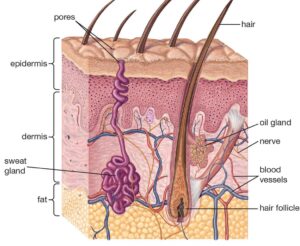
 Healthy skin starts with good nutrition. A dog’s/cat’s skin and coat require vitamins, minerals, essential fatty acids, and other nutrients. A low-quality diet can leave their coat looking dry, cause dandruff and make the pet prone to skin infections. As with other health conditions, prevention is the best policy. Regularly brushing your furry babies prevents skin infections because it helps remove allergens and helps condition their skin. Start by petting your baby, next carefully inspect the skin taking notice of any lumps, bumps, cuts, scabs, or scaly skin. Regular bathing is also as important to maintain a healthy coat. If you are like most of us and tend to delay your furry baby’s bath because it is a struggle, make a habit of taking your doggy/kitty to a professional groomer. However, if you are a DIY-kind of person make sure that you use best quality dog/cat shampoos, conditioners and brushes specifically made for your pet’s breed and coat type.
Healthy skin starts with good nutrition. A dog’s/cat’s skin and coat require vitamins, minerals, essential fatty acids, and other nutrients. A low-quality diet can leave their coat looking dry, cause dandruff and make the pet prone to skin infections. As with other health conditions, prevention is the best policy. Regularly brushing your furry babies prevents skin infections because it helps remove allergens and helps condition their skin. Start by petting your baby, next carefully inspect the skin taking notice of any lumps, bumps, cuts, scabs, or scaly skin. Regular bathing is also as important to maintain a healthy coat. If you are like most of us and tend to delay your furry baby’s bath because it is a struggle, make a habit of taking your doggy/kitty to a professional groomer. However, if you are a DIY-kind of person make sure that you use best quality dog/cat shampoos, conditioners and brushes specifically made for your pet’s breed and coat type.
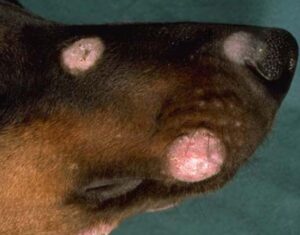
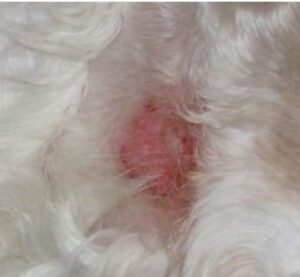
 Pets are not “mini people.” Animals react to substances in food and medicines differently from people. Most pets are much smaller than people, so what may seem like a harmless amount of a food or drug can make them ill
Pets are not “mini people.” Animals react to substances in food and medicines differently from people. Most pets are much smaller than people, so what may seem like a harmless amount of a food or drug can make them ill

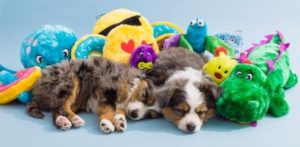 Well, you finally made the decision…whether this is your first puppy, or you had this experience before, this is an exciting time!! For the next few days, you will experience a wide range of feelings from “This’s the best decision of my life” to “OMG what have I done!” In other words you might feel that you entered the Twilight Zone…but just like bringing home your new born baby for the first time, this will be the beginning of many years of fun and love and licks that will fill your home with great memories of happiness and companionship!!
Well, you finally made the decision…whether this is your first puppy, or you had this experience before, this is an exciting time!! For the next few days, you will experience a wide range of feelings from “This’s the best decision of my life” to “OMG what have I done!” In other words you might feel that you entered the Twilight Zone…but just like bringing home your new born baby for the first time, this will be the beginning of many years of fun and love and licks that will fill your home with great memories of happiness and companionship!!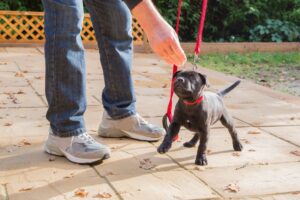
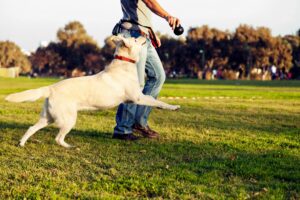
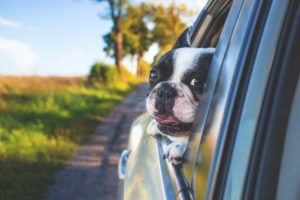 the breeder, your pup is between 7 and 12 weeks. This is a critical learning period that will last until he is about 16 weeks old, so make the most of this rapid learning stage. The goal is for him to have lots of positive experiences with friendly people, children, other dogs, and cats. During this time, your puppy should meet many different people, not just the same family members or friends. To get the numbers up, take your puppy for walks to different places, take him to short car rides and to do errands where you can introduce him to different people. Meeting new people and having lots of different experiences are important to help him cope and adapt to different situations. During these outings, take him to see his veterinarian for a short visit so he gets used to these visits. There are a few things your puppy should learn at this point: Meeting people is great; No teeth on people ever; No jumping up on people; Always potty outside.
the breeder, your pup is between 7 and 12 weeks. This is a critical learning period that will last until he is about 16 weeks old, so make the most of this rapid learning stage. The goal is for him to have lots of positive experiences with friendly people, children, other dogs, and cats. During this time, your puppy should meet many different people, not just the same family members or friends. To get the numbers up, take your puppy for walks to different places, take him to short car rides and to do errands where you can introduce him to different people. Meeting new people and having lots of different experiences are important to help him cope and adapt to different situations. During these outings, take him to see his veterinarian for a short visit so he gets used to these visits. There are a few things your puppy should learn at this point: Meeting people is great; No teeth on people ever; No jumping up on people; Always potty outside.
